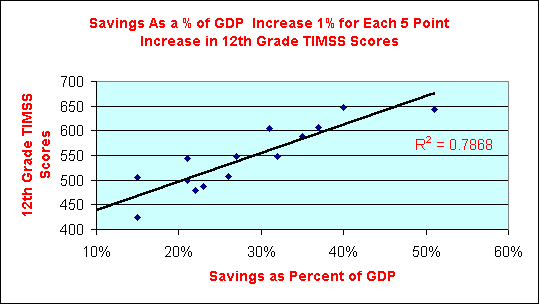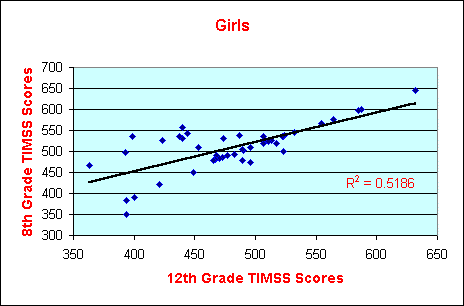|
|
|

The World's Only Negative Personal Savings Rate
The only industrialized nation in the world with a negative Personal Savings rate is the US.
The Bureau of Economic Analysis notes that Personal Savings in February 1999 were a negative $33 billion.
Even with this low savings rate, the federal government transferred more than $430 billion directly from men to women through the IRS with "tax credits".
Three quarters of American women believe "statistics mean nothing, I mean absolutely nothing" yet women constitute 11% more of the vote than men.
Gross Savings as a Percent of GDP in 14 Countries decrease 1% for each 5 point decrease in TIMSS Scores.
Restoring Personal Savings requires the replacement of feminism with arete, the banning of public education and the restoration of this Christian nation.
The most distinguishing feature of a graph of TIMSS scores vs. savings rates around the
world is the fact that the nations for which data is available all have both higher TIMSS
scores and higher rates of savings than the US and England. The European nations,
Australia, and New Zealand have TIMSS scores roughly 40 points higher and rates of savings
roughly 6% higher. Switzerland is at the high end of the European nations,  with a TIMSS score 45 points higher and a rate of
savings 12% higher. Japan, Korea, and Hong Kong are further up the scale, with TIMSS
scores 100 points higher and rates of savings 19% higher. At the top of the scale is
Singapore, with a TIMSS score 143 points higher and a rate of savings 36% higher.The
linearity of this relationship suggests that savings rates are strongly influenced by math
skills, or that higher savings rates provide the opportunity to educate children more
effectively, or a combination of both. Regardless of which is the predominant
relationship, it is strong evidence that an aggressive program to increase math education
quality in the US today has immense long term benefits tomorrow. A 1% increase in the rate
of savings as a percent of GDP in the US would put $70 billion more per year into savings.
An increase in the rate of savings to a level equivalent to Singapore would put $2,520
billion more per year into savings.Discussions about savings rates with American students
confirm this relationship. They also confirm that the low TIMSS scores do accurately
reflect their significantly impaired math skills today. Their propensity to save could not
be increased very much without completely restoring their competency in math. That cannot
be done until teachers are tested for math competency before they are hired. That requires
paying math teachers significantly more than current pay scales. That requires repealing
the "Equal Pay Act"."Arete" is the Greek word for
what needs to be done about math education--we must strive to put quality back into
education. That requires hiring the very best math educators possible.
with a TIMSS score 45 points higher and a rate of
savings 12% higher. Japan, Korea, and Hong Kong are further up the scale, with TIMSS
scores 100 points higher and rates of savings 19% higher. At the top of the scale is
Singapore, with a TIMSS score 143 points higher and a rate of savings 36% higher.The
linearity of this relationship suggests that savings rates are strongly influenced by math
skills, or that higher savings rates provide the opportunity to educate children more
effectively, or a combination of both. Regardless of which is the predominant
relationship, it is strong evidence that an aggressive program to increase math education
quality in the US today has immense long term benefits tomorrow. A 1% increase in the rate
of savings as a percent of GDP in the US would put $70 billion more per year into savings.
An increase in the rate of savings to a level equivalent to Singapore would put $2,520
billion more per year into savings.Discussions about savings rates with American students
confirm this relationship. They also confirm that the low TIMSS scores do accurately
reflect their significantly impaired math skills today. Their propensity to save could not
be increased very much without completely restoring their competency in math. That cannot
be done until teachers are tested for math competency before they are hired. That requires
paying math teachers significantly more than current pay scales. That requires repealing
the "Equal Pay Act"."Arete" is the Greek word for
what needs to be done about math education--we must strive to put quality back into
education. That requires hiring the very best math educators possible.
The correlation of savings to scores (r-squared = 0.7868) is higher than
the correlation of boys' 12th grade scores to boys' 8th grade scores (r-squared = 0.6932),
and even higher than the correlation of girls' 8th grade to 12th grade scores (r-squared =
0.5186). 

A=Country
B=Savings as % of GDP
C=12th Grade TIMSS Score
D=Feminism Taught in Schools
A B C D
Singapore 51% 643 no Malaysia 41% no China 40% 647 no South Korea 37% 607 no Indonesia 37% no Thailand 36% no Bhutan 36% no Hong Kong 35% 588 no Brunei 35% no Russia 32% 548 no Japan 31% 605 no Saudi Arabia 30% no Macau 28% no P. N. Guinea 28% no India 28% no Switzerland 27% 547 no New Zealand 26% 508 no Taiwan 25% no Germany 23% 487 no Italy 22% 480 no France 21% 544 no Canada 21% 499 Yes Brazil 21% Yes Kenya 21% Yes Nigeria 20% Yes Turkey 20% Yes Mexico 19% Yes Vietnam 16% Yes Philippines 16% Yes Sri Lanka 16% Yes Britain 15% 506 Yes U.S. 15% 424 Yes Mongolia 14% Yes Fiji 13% Yes Pakistan 12% Yes Maldives 11% Yes Nepal 11% Yes Myanmar 11% Yes Afghanistan 10% Yes Bangladesh 8% Yes Egypt 7% Yes Cambodia 6% Yes Laos 4% Yes